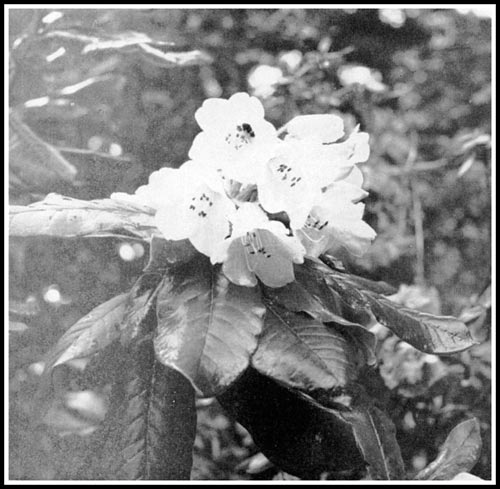QBARS - v11n4 R. glischrum (R. 162)
R. glischrum (R. 162)
By Rudolph Henny

|
|---|
Fig. 40 R. glischrum (R. 162) R. Henny photo |
R. glischrum (R.162) was reported in Dr. Rock's list of seeds sent from China in 1918 in the American Rhododendron Quarterly Bulletin, April, 1919, and this particular plant was found on Mt. Juch'uan-Shan at 11,000 feet in spruce forests. Identification of the herbarium was made at the Royal Botanic Garden. Edinburgh later in the same year, and was delivered there personally by the former Secretary of the American Rhododendron Society George Grace, along with a complete set of all the seeds of the species collected by the expedition.
These seeds were sown and a number of seedlings have been raised, and in 1956 there appeared in the American Rhododendron Society Bulletin Vol. 40., No. 1, pp. 204-12, a list of the Dr. Rock numbers with twenty-two changes where the growing specimen at Edinburgh did not coincide with the original herbarium specimens. I mention the above only since the element of human error could have arisen from all who handled the seed in its disposition to the very natives who collected the seed. In this case however where two nearly alike species were growing side by side, the possibility of taking seeds from both, points very strongly to the native collector.
One of this group of R. glischrum (R. 162) bloomed in the editor's garden in the spring of 1957 (my notes show April 11) and was a good yellow rather than the dull crimson of R. glischrum . A number of members of the Society who are interested in species after seeing it identified it as R. glischroides (Fig. 40) which it undoubtedly is. The color came out as a bright yellow but this quickly changed to cream, each flower contained a bright red basal blotch, and were ten to twelve in a good upright truss. Only one other plant of Rock 162 remains in the editor's collection, the others were donated to new members of the Society during the years 1950-1, so possibly a number of them are still about since the plant is very hardy. The single remaining plant of Rock 162 does not have the shiny dark green foliage associated with the plant that bloomed and I presume it is R. glischrum .
In checking only very casually in the Society Test Garden at Crystal Springs in mid August, I failed to find R. 162, but it undoubtedly is there.

